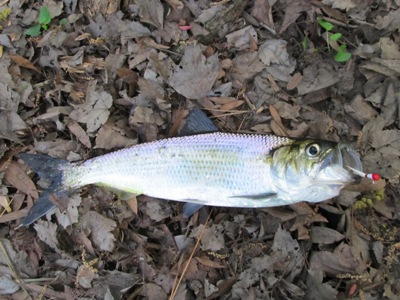
American shad, hickory shad, blueback herring, and alewives were once incredibly abundant in rivers, creeks, and streams of the Chesapeake Bay Watershed. Although stocks have declined in the estuary, some species have begun to increase as a result of restoration efforts.
Adult fish reside in marine environments until they reach maturity. To complete their complex life cycles, shad and river herring return in early spring to freshwater rivers, and creeks to spawn. Biologists suspect that shad and river herring returning to the Chesapeake Bay may have traveled 1000 miles or more during their lifetime.
American and hickory shad are the largest of the four anadromous species. The hickory shad usually more plentiful of the two species.
The term river herring is collectively applied to two species of fish, the alewife (Alosa aestivalis), and blueback herring (Alosa psuedoharengus). Both species of river herring rarely exceed 15 inches.
The alewife is bright silver in color, with a dark back, and black spot directly behind the gill opening. Some individuals exhibit up to 9 dark spots of varying intensity along the upper body. Their underside comes to a point with a single row of scales folded over the edge, resulting in a sharp saw like edge.
The blueback herring has a bluish-green back and a more elongated body than the alewife. The most distinguishing characteristic of these species is the color of their peritoneum (abdominal cavity lining). The alewife’s peritoneum is pale with dusky spots while the blueback herring’s peritoneum is dark gray to black in color.
Shad and river herring are caught by recreational anglers. In spring, anglers congregate along rivers and creeks, casting shad darts, small jigs, or spoons to catch shad and river herring. Fly fishermen also catch these fish using small, shiny fly patterns.
Anadromous shad and river herring along the Atlantic coast are managed cooperatively by the Atlantic States Marine Fisheries Commission (ASMFC).
Related Information